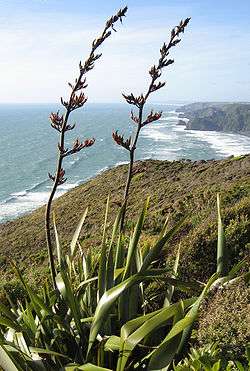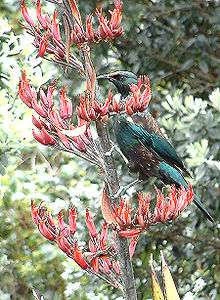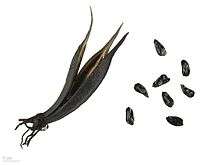Phormium
| New Zealand flax | |
|---|---|
 | |
| Phormium tenax in bloom in Piha, west Auckland, New Zealand | |
| Scientific classification | |
| Kingdom: | Plantae |
| Clade: | Angiosperms |
| Clade: | Monocots |
| Order: | Asparagales |
| Family: | Asphodelaceae |
| Subfamily: | Hemerocallidoideae |
| Genus: | Phormium J.R. Forst. & G. Forst. |
| Type species | |
| Phormium tenax | |
| Species | |
Phormium is a genus of two plant species in the Asphodelaceae family. One species is endemic to New Zealand and the other is native to New Zealand and Norfolk Island.[1] The two species are widely known in New Zealand as 'flax' and elsewhere as New Zealand flax or flax lily but are not related to flax which is native to the region extending from the eastern Mediterranean to India and which was used by humans in 30,000 B.C.[2][3]
Taxonomy
Phormium is an herbaceous perennial monocot. Monocot classification has undergone significant revision in the past decade, and recent classification systems (including the Angiosperm Phylogeny Group) have found Phormium to be closely related to daylilies (Hemerocallis), placing it in family Asphodelaceae, subfamily Hemerocallidoideae. Phormium formerly belonged to the family Agavaceae and many classification systems still place it there. It includes two species, Phormium colensoi and Phormium tenax. It also includes many cultivars.
The genus was originally established by the German naturalists Johann Reinhold Forster and his son Georg Forster in 1775 from specimens of Phormium tenax collected by both Forsters and the Swedish naturalist Anders Erikson Sparrman. All of them were part of the second expedition of Captain James Cook aboard the Resolution (1772–1775).[4] The type specimens were taken from Queen Charlotte Sound, with additional specimens from both Norfolk Island and North Island, New Zealand.[5] The name Phormium comes from Ancient Greek for "basket", while tenax was Latin for "strong".
Description and ecology


The tough, sword-shaped leaves grow up to three metres long and up to 125 mm wide. They are usually darkish green but sometimes have coloured edges and central ribs. Cultivated varieties range from light green through pink to deep russet bronze. There are numerous variegated cultivars with leaves marked by contrasting stripes in shades of green, red, bronze, pink and yellow.
The rigid flower stalks can be up to five metres long, projecting high above the foliage. In November (in New Zealand) they produce clumps of curving tube-like flowers which turn bright red when mature. These produce unusually large quantities of nectar to attract all nectar feeding birds such as the tui and insects. The seedpods that develop after pollination, each contain hundreds of seeds which are later widely dispersed by the wind.
Distribution and habitat
Phormium tenax occurs naturally in New Zealand and Norfolk Island, while P. colensoi is endemic to New Zealand. Both species have been widely distributed to temperate regions of the world as economic fibre and ornamental plants.[6]
They are found mainly in swamps or low-lying areas but will grow just about anywhere
Cultivation
The two species readily interbreed and there is part considerable regional variation in Phormium colensoi.[7] Where the two species co-occur, there is local introgression.[8]
In recent years there has been a dramatic increase in the number of Phormium cultivars commercially available. The 2005-2006 edition of the Royal Horticultural Society Plant Finder listed 75 cultivars. As early as the 1920s it was recognised that ploidy plays a role in some cultivars due to the work of John Stuart Yeates.[9] The highly regarded sport Ngaro[10] was isolated from the Moutoa swamp, Foxton.[11]
The following cultivars have gained the Royal Horticultural Society's Award of Garden Merit for growing in UK gardens:
Uses
Phormium produces long leaf fibres that have played an important role in the culture, history, and economy of New Zealand. Both species have been widely distributed to temperate regions of the world as economic fibre and ornamental plants.
References
- ↑ Moore, L.B.; Edgar, E. (1970). Flora of New Zealand. Vol. II. Indigenous Tracheophyta: Monocotyledones except Gramineae. Wellington, N. Z.
- ↑ Balter, M (2009). "Clothes make the (Hu) Man". Science. 325 (5946): 1329. doi:10.1126/science.325_1329a. PMID 19745126.
- ↑ Kvavadze, E; Bar-Yosef, O; Belfer-Cohen, A; Boaretto, E; Jakeli, N; Matskevich, Z; Meshveliani, T (2009). "30,000-Year-Old Wild Flax Fibers". Science. 325 (5946): 1359. doi:10.1126/science.1175404. PMID 19745144. Supporting Online Material
- ↑ Peter Coyne (2009). "Phormium tenax (New Zealand Flax)— Norfolk Island native?" (PDF). Cunninghamia. 11 (2): 167–170.
- ↑ Kevin Mills (2009). "Was Phormium tenax introduced to Norfolk Island by the Polynesians?" (PDF). Cunninghamia. 11 (2): 171–175.
- ↑ Extraction, content, strength, and extension of Phormium variety fibres prepared for traditional Maori weaving, New Zealand Journal of Botany, 2000, Vol. 38: pg. 469.
- ↑ http://www.tandfonline.com/doi/abs/10.1080/0028825X.1979.10426888
- ↑ http://www.tandfonline.com/doi/abs/10.1080/00288250809509767
- ↑ "Papers Past — Evening Post — 21 December 1929 — FLAX RESEARCH". paperspast.natlib.govt.nz. 2011. Retrieved 24 October 2011.
- ↑ paperspast.natlib.govt.nz/cgi-bin/paperspast?a=d&cl=search&d=EP19291221.2.108
- ↑ "Maori dictionary - ngaro". Retrieved 26 May 2013.
- ↑ "RHS Plant Selector - Phormium colensoi subsp. hookeri 'Cream Delight'". Retrieved 26 May 2013.
- ↑ "RHS Plant Selector - Phormium colensoi subsp. hookeri 'Tricolor'". Retrieved 26 May 2013.
- ↑ "RHS Plant Selector - Phormium 'Duet'". Retrieved 26 May 2013.
- ↑ "RHS Plant Selector - Phormium 'Sundowner'". Retrieved 26 May 2013.
- ↑ "RHS Plant Selector - Phormium tenax 'Variegatum'". Retrieved 26 May 2013.
- ↑ "RHS Plant Selector - Phormium 'Yellow Wave'". Retrieved 26 May 2013.
| Wikimedia Commons has media related to Phormium. |
| Wikispecies has information related to: Phormium |